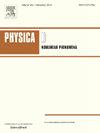How to quantify interaction strengths? A critical rethinking of the interaction Jacobian and evaluation methods for non-parametric inference in time series analysis
IF 2.7
3区 数学
Q1 MATHEMATICS, APPLIED
引用次数: 0
Abstract
Quantifying interaction strengths between state variables in dynamical systems is essential for understanding ecological networks. Within the empirical dynamic modeling approach, multivariate S-map infers the interaction Jacobian from multivariate time series data without assuming specific dynamical models. This approach enables the non-parametric statistical inference of interspecific interactions through state space reconstruction. However, deviations in the biological interpretation and numerical implementation of the interaction Jacobian from its unique mathematical definition pose challenges. We mathematically reintroduce the interaction Jacobian by starting our derivation with differential quotients, uncovering two key problems: (1) the mismatch between the interaction Jacobian and its biological meaning complicates comparisons between interspecific and intraspecific interaction strengths; (2) the interaction Jacobian is not fully implemented in the parametric Jacobian numerically derived from given parametric models, especially ordinary differential equation models. As a result, model-based evaluations of S-map methods become inappropriate. To address these problems, (1) we propose adjusting the diagonal elements of the interaction Jacobian by subtracting 1 to resolve the comparability problem between interspecific and intraspecific interaction strengths. Simulations of population dynamics showed that this adjustment prevents overestimation of intraspecific interaction strengths, allowing for meaningful comparisons. (2) We introduce an alternative parametric Jacobian and then cumulative interaction strength (CIS), providing a more rigorous benchmark for evaluating S-map methods. Furthermore, we demonstrated that the numerical gap between CIS and the existing parametric Jacobian is substantial in realistic scenarios, suggesting CIS as a preferred benchmark for future evaluations. These solutions offer a clearer framework for developing non-parametric approaches in ecological time series analysis.

量化动态系统中状态变量之间的相互作用强度对于理解生态网络至关重要。在经验动态建模方法中,多变量 S-map 可以从多变量时间序列数据中推断出相互作用雅各比,而无需假设特定的动态模型。这种方法可以通过状态空间重建对种间相互作用进行非参数统计推断。然而,相互作用雅各比的生物解释和数值实现与其独特的数学定义存在偏差,这给我们带来了挑战。我们从微分商开始推导,从数学上重新引入了相互作用雅各比,发现了两个关键问题:(1)相互作用雅各比与其生物学含义之间的不匹配使种间和种内相互作用强度的比较变得复杂;(2)从给定的参数模型,特别是常微分方程模型数值推导出的参数雅各比中没有完全实现相互作用雅各比。因此,基于模型的 S-图方法评估变得不合适。为了解决这些问题,(1) 我们建议通过减去 1 来调整相互作用雅各比对角线元素,以解决种间和种内相互作用强度之间的可比性问题。种群动态模拟结果表明,这种调整可以防止高估种内相互作用强度,从而进行有意义的比较。(2) 我们引入了另一种参数雅各比,然后是累积相互作用强度(CIS),为评估 S-图方法提供了一个更严格的基准。此外,我们还证明了 CIS 与现有参数雅各比之间在现实情况下的数值差距很大,这表明 CIS 是未来评估的首选基准。这些解决方案为在生态时间序列分析中开发非参数方法提供了更清晰的框架。
本文章由计算机程序翻译,如有差异,请以英文原文为准。
求助全文
约1分钟内获得全文
求助全文
来源期刊

Physica D: Nonlinear Phenomena
物理-物理:数学物理
CiteScore
7.30
自引率
7.50%
发文量
213
审稿时长
65 days
期刊介绍:
Physica D (Nonlinear Phenomena) publishes research and review articles reporting on experimental and theoretical works, techniques and ideas that advance the understanding of nonlinear phenomena. Topics encompass wave motion in physical, chemical and biological systems; physical or biological phenomena governed by nonlinear field equations, including hydrodynamics and turbulence; pattern formation and cooperative phenomena; instability, bifurcations, chaos, and space-time disorder; integrable/Hamiltonian systems; asymptotic analysis and, more generally, mathematical methods for nonlinear systems.
 求助内容:
求助内容: 应助结果提醒方式:
应助结果提醒方式:


